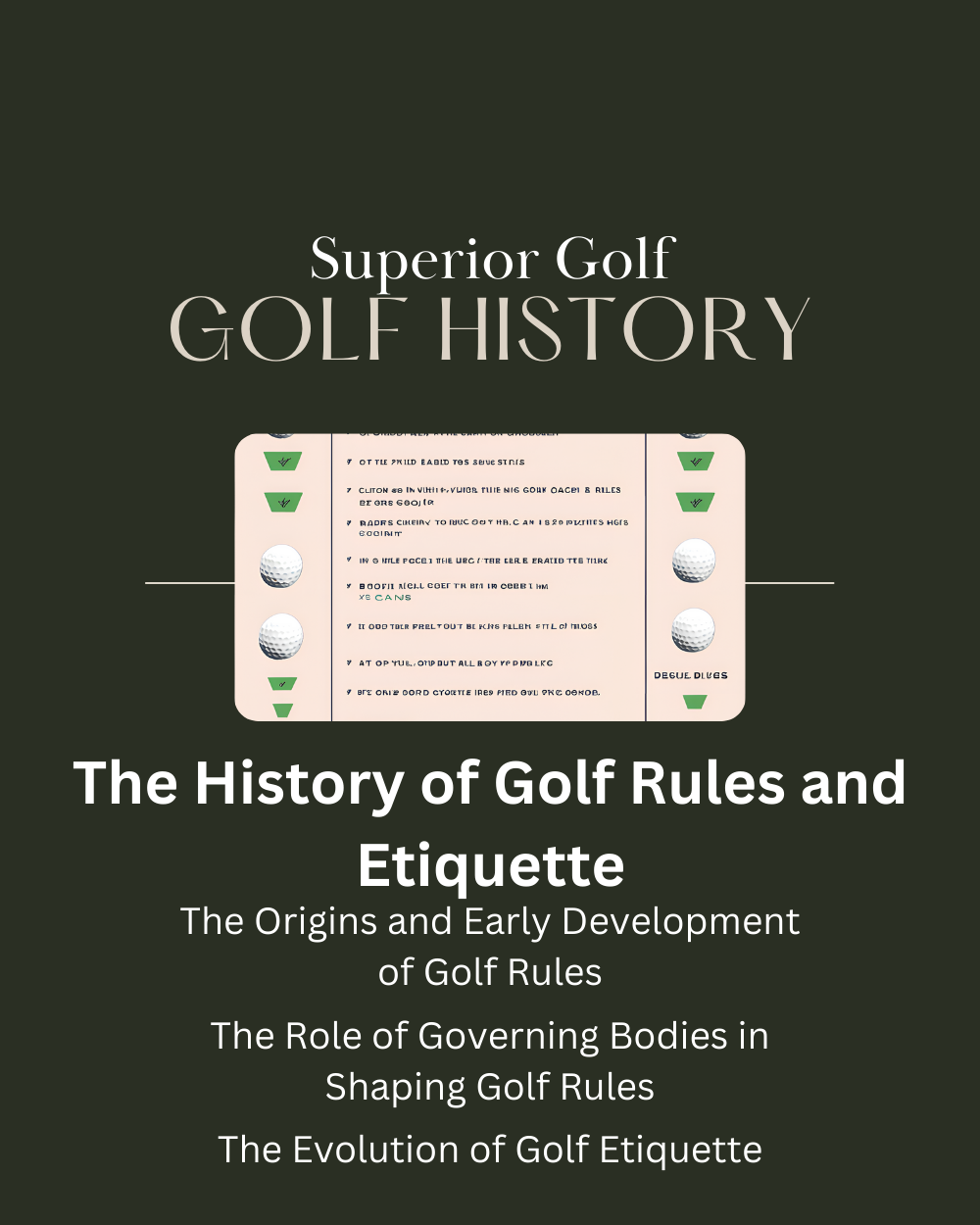The History of Golf Rules and Etiquette: The first written golf rules appeared in 1744 for a match in Edinburgh1. They were made for the Leith links competition. These “13 Articles” were by The Gentlemen Golfers of Leith, who are now known as the Honourable Company of Edinburgh Golfers. They laid down the basics of today’s golf2. Golf rules have changed over the years to match new course designs, equipment, and play methods2.
Changes in rules happened in 1899, 1934, 1952, and 1984 to make the game straightforward and fair. This came after detailed discussions among players2. These changes aimed to make rules easier to follow, consistent, and to keep the game honest.
Famous Scottish golf clubs, like the Gentlemen Golfers of Leith, set up the foundation for golf’s rules. In the next hundred years, over thirty clubs made their own rules. They often used the “13 Articles” as a guide to solve course-specific problems2. This ongoing change reflects golf’s long history, blending tradition with new ideas to keep the game enjoyable.
Key Takeaways
- The earliest known written golf rules were established in 1744 for a competition on the Leith links, Edinburgh1.
- The Gentlemen Golfers of Leith, now the Honourable Company of Edinburgh Golfers, played a crucial role in drafting these foundational “13 Articles”2.
- More than thirty clubs adopted individual rule codes to address specific course conditions and challenges over the following century2.
- Major revisions of golf rules occurred in 1899, 1934, 1952, and 1984, aiming to simplify and ensure the integrity of the game2.
- Renowned golf societies in Scotland were pivotal in establishing clear gameplay rules, contributing to the game’s tradition and evolution2.
The Origins and Early Development of Golf Rules
The story of golf rules started in 1744 with the “13 Articles” by the Gentlemen Golfers of Edinburgh. They made these rules for the world’s first ‘open’ golf contest at Leith, setting the stage for all golf rules to come1. John Rattray was key in this, signing as Captain1.
The Birth of the 13 Articles
The “13 Articles” gave golf contests their first real rules. They covered teeing off, hazards, and what to do with lost balls3. These rules were just the start. Over time, other golfers, like those at St Andrews in 1754, changed Rule 5 to make it better3.
Influence of Scottish Golf Societies
Golf societies in Scotland, like the Society of St. Andrews Golfers, shaped the rules to fit their courses1. They made rules that matched their land and challenges. One example is the Thistle Golf Club’s rules from 1824, with golf’s first history1. All these clubs working together showed how collaboration was key.
Variations and Adaptations in Early Rules
Different golf courses led to different rules early on4. Rules like the stymie showed big differences between places like Leith and Brunonian1. In the 18th and 19th centuries, clubs worked to make rules fairer for everyone1. This effort led to the R&A’s first ‘national’ rules in 18991.
The Role of Governing Bodies in Shaping Golf Rules
The R&A and the USGA are key in making golf rules. They work together to keep the game fair everywhere.
Formation of The R&A and USGA
The R&A began in the late 19th century, sharing golf rules5. At the same time, the USGA formed in 1894, inspired by The R&A but with a focus on America’s needs5. This led to different rules for each group.
Key Changes and Standardization Efforts
The R&A and USGA update golf’s rules every four years5. The first rules appeared in 17445. In 2020, they started the World Handicap System, streamlining handicaps worldwide5. They aim for universal golf rules together since 19525.
There have been major updates, like clubhead and groove changes56. For example, new groove rules began on January 1, 2010, for all new clubs7. These changes help keep the game competitive and fair.
Golf clubs can set local rules for specific issues5. The R&A and USGA clarify rules every two years5.
The R&A and USGA’s teamwork promotes a unified global golf game. This makes golf fair and fun for everyone.
The Evolution of Golf Etiquette
Golf etiquette started in 15th century Scotland. It formed the culture, encouraging respect and good sportsmanship since then8. Players followed rules on how to dress, behaved nicely to others, and took good care of the golf course8. These traditions live on, showing how golf values respect and its deep-rooted traditions.
The Roots of Respect and Integrity
Golf’s etiquette is about more than just playing the game. It includes dignity, fairness, and friendship among players8. Actions like staying quiet during shots and cheering on others helped create a friendly, respectful atmosphere8. This foundation has shaped today’s golf world, keeping respect and integrity at its core.
Modern Etiquette Practices
The way we follow golf etiquette has changed, blending old customs with new ideas8. Keeping the game moving and fixing ball marks are still key8. Now, there’s ‘ready golf’ to make play faster but keep it fair. Tech also helps honor golf’s past. For example, Cart Tek offers tools like remote control caddies8.
| Traditional Etiquette | Modern Practices |
|---|---|
| Maintaining silence during shots | ‘Ready golf’ to speed up play |
| Repairing ball marks and divots | Using digital tools like GPS devices |
| Encouraging fellow players | Electric trolleys for convenience |
Using tech like GPS and apps is now common in golf8. These tools help players find their way around courses more easily8. Such changes show how golf keeps evolving, welcoming new ideas while holding on to its rich traditions.
In conclusion, mixing old and new etiquette helps maintain the sport’s spirit. Golf balances its history with modern needs, looking back while moving forward.
Conclusion
The history and growth of golf’s rules and etiquette have come a long way. They started with the “13 Articles” and have evolved with new technologies, making sure the game stays fair. Key organizations like The R&A and USGA have been crucial in keeping the rules consistent, helping golf communities worldwide follow a common set of standards based on golf’s rich history.
It’s important to mix tradition with new ideas to keep golf honest. Governing bodies also focus on teaching good manners, like being respectful and practicing sportsmanship. Fixing divots, dressing properly, and playing quickly are parts of these manners. They keep the respected traditions of golf alive.
Golf stays fresh and relevant by regularly updating its rules and respecting its past. When you play golf, think about how its history and rules shape the game today. It shows how much golf honors its past while moving forward. Thanks to ongoing teamwork among golf experts, we give a nod to where the sport began while embracing the future.
FAQ
What are the origins of golf rules and etiquette?
How did the “13 Articles” influence the early development of golf rules?
What role did Scottish golf societies play in shaping early golf rules?
How did variations in early golf rules arise?
What are The R&A and US withGA’s roles in golf rulemaking?
What were the key changes introduced in golf rules?
How has golf etiquette evolved over time?
What are some modern-day golf etiquette practices?
Why is adhering to golf etiquette important?
Source Links
- https://www.scottishgolfhistory.org/origin-of-golf-terms/rules-of-golf/
- https://www.usga.org/rules-hub/rules-modernization/text/a-brief-history-1744-to-present.html
- https://golfcollege.edu/original-13-rules-golf/
- https://blog.ansi.org/a-brief-history-of-golf/
- https://en.wikipedia.org/wiki/Rules_of_golf
- https://www.bbc.com/sport/golf/67634695
- https://www.espn.com/golf/news/story?id=3520888
- https://www.carttek.com/blogs/golf-equipment-blog/golf-etiquette-and-culture-traditions-and-modern-changes

